AMD's Richland vs. Intel's Haswell GPU on the Desktop: Radeon HD 8670D vs. Intel HD 4600
by Anand Lal Shimpi on June 6, 2013 12:00 PM ESTMetro: Last Light
Metro: Last Light is the latest entry in the Metro series of post-apocalyptic shooters by developer 4A Games. Like its processor, Last Light is a game that sets a high bar for visual quality, and at its highest settings an equally high bar for system requirements thanks to its advanced lighting system. This doesn’t preclude it from running on iGPUs thanks to the fact that it scales down rather well, but it does mean that we have to run at fairly low resolutions to get a playable framerate.
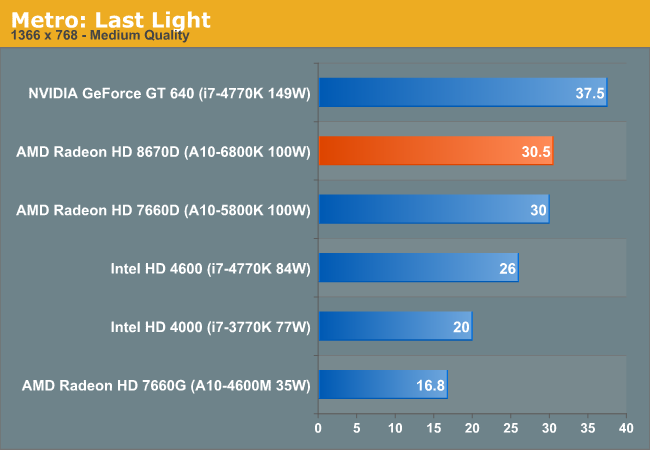
Looking at desktop parts alone, Intel really suffers from not having a socketed GT3 SKU. Although HD 4600 is appreciably faster than HD 4000 (+30%), both Trinity and Richland are around 17% faster than it. As you'll see, Metro ends up being one of the smaller gaps between the two in our suite.
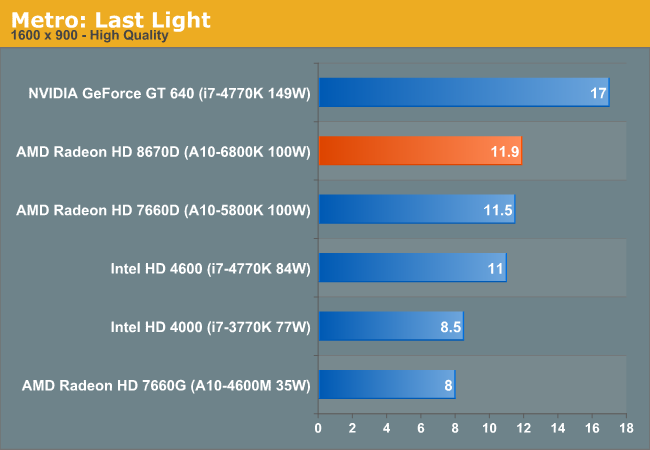
As memory bandwidth becomes the ultimate bounding condition, the gap between Richland and Haswell shrinks considerably. Note that on the HD 4600 side, the difference between DDR3-1333 and DDR3-2400 is only 10% here. Given the limited performance of the 20 EU Haswell GPU configuration, it doesn't seem like Intel is all that bandwidth limited here.
BioShock: Infinite
Bioshock Infinite is Irrational Games’ latest entry in the Bioshock franchise. Though it’s based on Unreal Engine 3 – making it our obligatory UE3 game – Irrational had added a number of effects that make the game rather GPU-intensive on its highest settings. As an added bonus it includes a built-in benchmark composed of several scenes, a rarity for UE3 engine games, so we can easily get a good representation of what Bioshock’s performance is like.
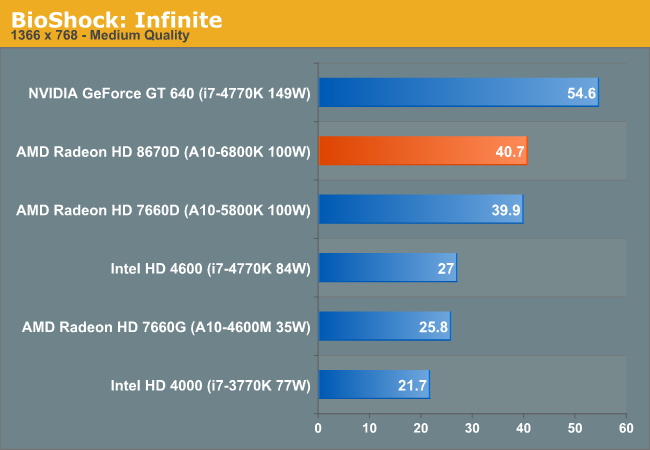
If Metro was an example of the worst case scenario for Richland, BioShock: Infinite is the best case scenario. Here the Radeon HD 8670D holds a 50% performance advantage over Intel's HD 4600 graphics.
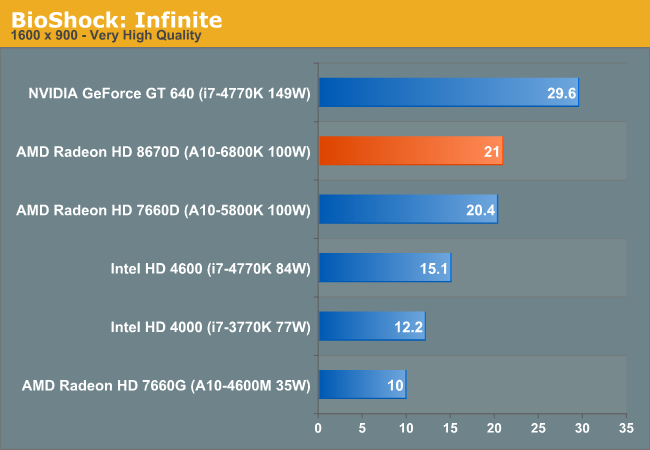
The gap narrows a bit at higher resolution/quality settings, but it's still 39%.
Sleeping Dogs
A Square Enix game, Sleeping Dogs is one of the few open world games to be released with any kind of benchmark, giving us a unique opportunity to benchmark an open world game. Like most console ports, Sleeping Dogs’ base assets are not extremely demanding, but it makes up for it with its interesting anti-aliasing implementation, a mix of FXAA and SSAA that at its highest settings does an impeccable job of removing jaggies. However by effectively rendering the game world multiple times over, it can also require a very powerful video card to drive these high AA modes.
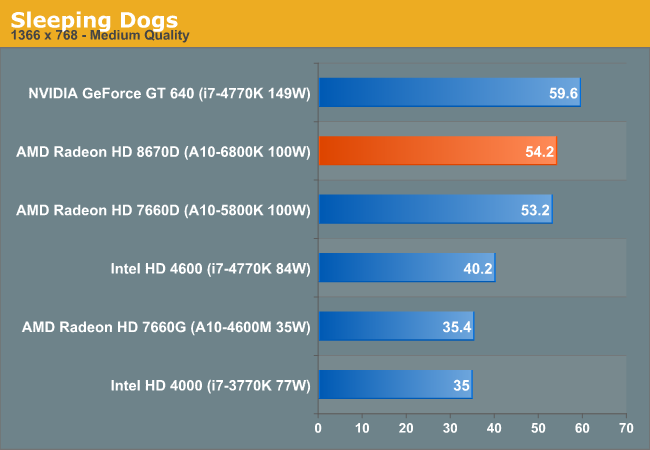
Richland is approaching 60 fps in our Sleeping Dogs benchmark at medium quality, definitely not bad at all. The advantage over Intel's HD 4600 is 34%.
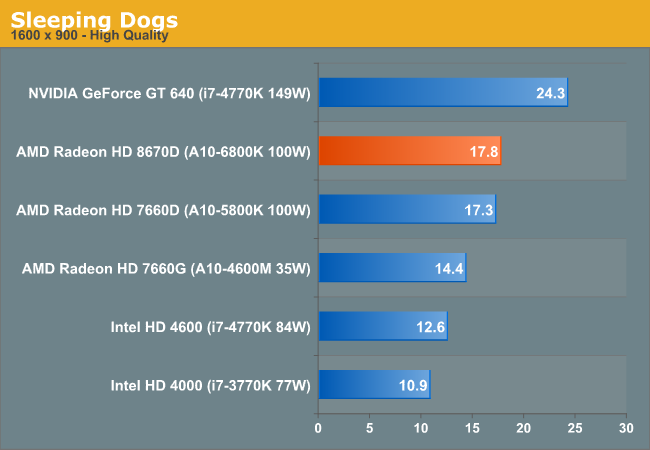
The performance advantage grows a bit at the higher quality/resolution settings, however we drop below the line of playability. With most of these games, you can trade off image quality for resolution however.
Tomb Raider (2013)
The simply titled Tomb Raider is the latest entry in the Tomb Raider franchise, making a clean break from past titles in plot, gameplay, and technology. Tomb Raider games have traditionally been technical marvels and the 2013 iteration is no different. iGPUs aren’t going to have quite enough power to use its marquee feature – DirectCompute accelerated hair physics (TressFX) – however even without it the game still looks quite good at its lower settings, while providing a challenge for our iGPUs.

Tomb Raider is another title that doesn't put Richland in the best light, but it still ends up around 23% faster than Haswell GT2.
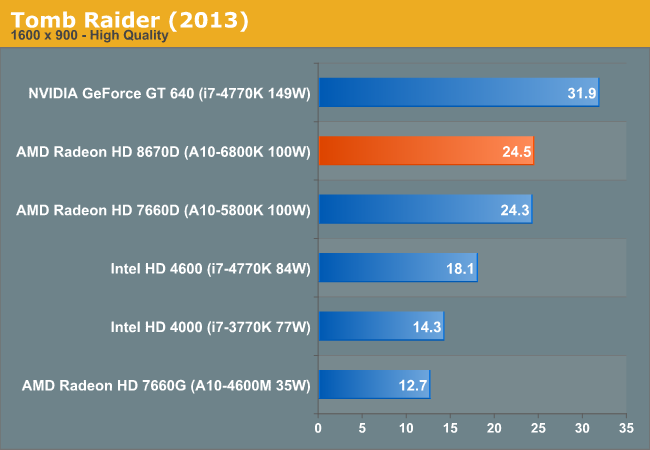
Battlefield 3
Our multiplayer action game benchmark of choice is Battlefield 3, DICE’s 2011 multiplayer military shooter. Its ability to pose a significant challenge to GPUs has been dulled some by time and drivers at the high-end, but it’s still a challenge for more entry-level GPUs such as the iGPUs found on Intel and AMD's latest parts. Our goal here is to crack 60fps in our benchmark, as our rule of thumb based on experience is that multiplayer framerates in intense firefights will bottom out at roughly half our benchmark average, so hitting medium-high framerates here is not necessarily high enough.
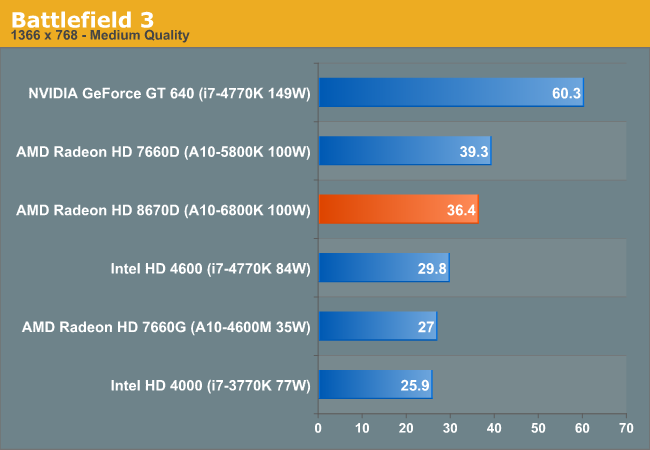
Richland's performance in Battlefield 3 climbs around 30% over the HD 4600 regardless of quality/resolution.

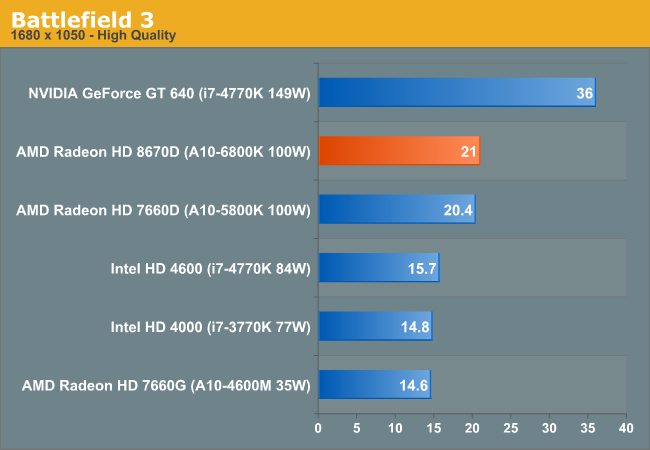
Crysis 3
With Crysis 3, Crytek has gone back to trying to kill computers, taking back the “most punishing game” title in our benchmark suite. Only in a handful of setups can we even run Crysis 3 at its highest (Very High) settings, and the situation isn't too much better for entry-level GPUs at its lowest quality setting. In any case Crysis 1 was an excellent template for the kind of performance required to drive games for the next few years, and Crysis 3 looks to be much the same for 2013.

Crysis is another benchmark where we see an increase in performance in the low 30% range.
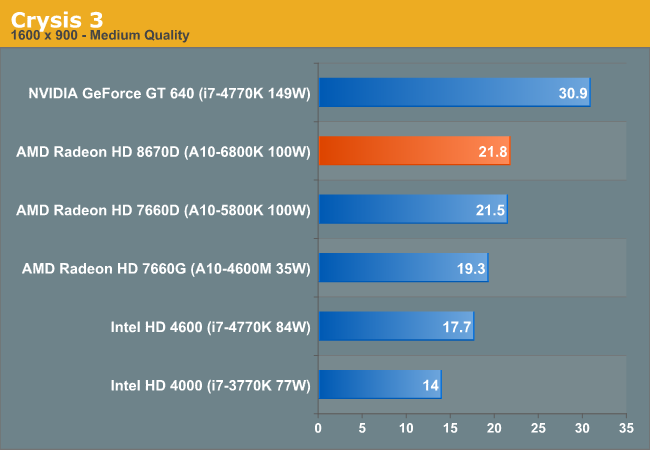











102 Comments
View All Comments
Death666Angel - Sunday, June 9, 2013 - link
"Who would buy it?" If it was just the added cost of the eDRAM put on top of the -K SKU (so 50€ or something on top of the i5-4670K and i7-4770K) I'd buy it in a heartbeat. First of all, it offers better QS functionality and second of all, the 128MB L4 cache is not exclusive to the iGPU, but can be used for the CPU as well, which offers some serious performance gains in programs that can make use of it.shinkueagle - Sunday, June 9, 2013 - link
Because it stupid to make such a comparison... And even more stupid of you to bring up such NONSENSE....gfluet - Monday, June 10, 2013 - link
Mostly because there are no Desktop Crystalwells yet, and the comparios is between socketed CPUs.But yeah, I look forward to when AnandTech gets a review model of the I7-4770R. I want to put one of those in a supercompact system.
Ewram - Thursday, June 6, 2013 - link
Excuse me, but what is the MSRP of the A10-6800k versus the i7-4770k? Also, wouldn't benchmarks also be affected by CPU performance to at least some extent?3DoubleD - Thursday, June 6, 2013 - link
Given how GPU and memory bandwidth limited these systems are, I'm sure the difference in CPU performance plays only a small if not negligible role in the final score.Even if we were talking a single 7970, the difference between AMD and Intel was pretty insignificant http://anandtech.com/show/6985/choosing-a-gaming-c...
CannedTurkey - Thursday, June 6, 2013 - link
The i7-4770 is roughly double the price of the A10-6800.BSMonitor - Thursday, June 6, 2013 - link
MSRP really isn't a valid comparison here as they are entirely different price points/target audiences. The point is to test the iGPU capability.AMD and Intel have very different approaches to iGPU and processor SKU's, today. AMD and it's Fusion are specifically targeting low price points where AMD believes the value of an iGPU is most attractive. The CPU cores are similar to its FX line, but it's an entirely different die than its flagship desktop parts which have NO iGPU whatsoever.
Intel on the desktop for the mostpart has a single die for all its mainstream Core i7's down to budget Core i3, Pentiums. The Core i7's iGPU isn't really focused on giving a budget gaming experience. And this is where Anand's criticism is aimed. They could make an amazing APU with a very balanced iGPU and CPU on the high end desktop parts but have chosen not to. It would seem the powers that be have decided there is no market for Iris Pro and its high end desktop parts.
MSRP would be a valid comparison in the Mobile Core i7 with Iris Pro vs the Richland Mobile parts.
silverblue - Thursday, June 6, 2013 - link
Perhaps. In that case, the price of the CPU would be partially obscured by the total BOM. If Iris Pro is that good, and you got double performance for twice the price, it wouldn't be too bad.Concillian - Thursday, June 6, 2013 - link
"Intel on the desktop for the mostpart has a single die for all its mainstream Core i7's down to budget Core i3, Pentiums. "Not true. Dual core and quad core have had different silicon since they started the i3 / i5 / i7 naming convention. I'm no mobile expert, but I know that on the desktop i3 has never had the same die as i7.
eanazag - Thursday, June 6, 2013 - link
A10-6800K is sitting around $150 on Newegg, while the 4770K is pushing $349 daisies. The comparison is still sensible and useful. Spend less money on Intel CPU and the clocks go down. So in an iGP setting for gaming AMD makes more sense, but if you throw a discrete card in the mix you'll have to rethink what your goals are. After staring at those prices, for a gaming only rig I might rather spend the price difference on a discrete card and call it a day if the monitor resolution is 1080p or less.